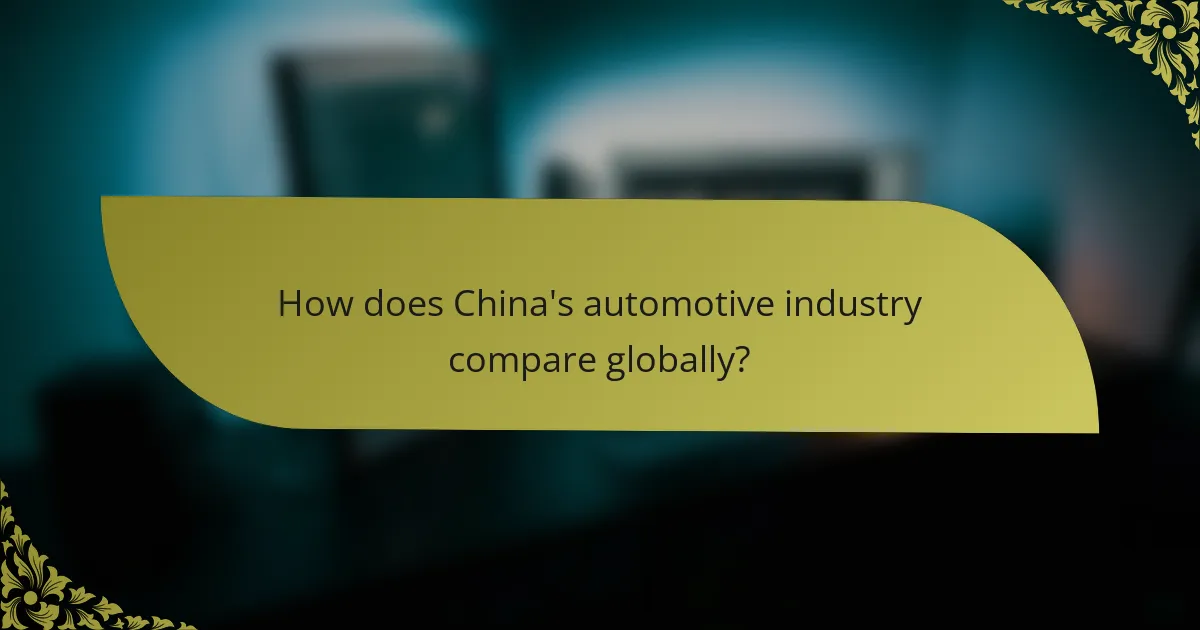China’s automotive industry is the largest in the world, characterized by significant manufacturing capabilities, a complex supply chain, and rapid innovation, particularly in electric vehicle (EV) technology. In 2022, China produced over 26 million vehicles, leading global production and sales, with more than 6 million electric vehicles sold in 2021 alone. Consumer preferences are shifting towards EVs, with over 25% of new car sales being electric, driven by demands for advanced technology, safety, and affordability. Major manufacturers like BYD and NIO are expanding internationally, supported by strong government initiatives and increasing investments in automotive technology and infrastructure. This article analyzes these trends, highlighting the competitive landscape and evolving consumer behavior within China’s automotive sector.

What are the key components of China’s automotive industry?
The key components of China’s automotive industry include manufacturing, supply chain, and innovation. Manufacturing encompasses vehicle assembly, which is dominated by both domestic and international automakers. The supply chain involves a vast network of parts suppliers, including battery manufacturers for electric vehicles. Innovation is driven by advancements in electric vehicle technology and autonomous driving systems. In 2022, China produced over 26 million vehicles, making it the largest automotive market globally. The country is also a leader in electric vehicle sales, with over 6 million units sold in 2021. This growth reflects strong government support and consumer demand for sustainable transportation options.
How has the automotive industry evolved in China over the years?
The automotive industry in China has evolved significantly over the years. Initially, it began in the early 20th century with limited production. By the 1980s, reforms led to joint ventures with foreign manufacturers. This boosted technology transfer and production capacity. In 2009, China became the world’s largest automotive market. The shift towards electric vehicles started around 2010, driven by government incentives. By 2020, electric vehicle sales surged, making up a substantial portion of total sales. China’s automotive industry now emphasizes innovation and sustainability. The country leads in electric vehicle production and adoption globally.
What historical events have shaped the current state of the automotive industry in China?
The current state of the automotive industry in China has been shaped by several key historical events. The establishment of the People’s Republic of China in 1949 marked the beginning of state-controlled automotive manufacturing. In the 1980s, China opened its market to foreign investment, leading to joint ventures with global automakers. The introduction of the “Open Door Policy” in 1978 catalyzed this transformation.
The accession to the World Trade Organization (WTO) in 2001 further integrated China into the global automotive market. This event increased competition and encouraged domestic manufacturers to innovate. The government’s push for electric vehicles (EVs) began in the early 2000s, driven by environmental concerns and energy security.
In 2015, the “Made in China 2025” initiative aimed to position China as a leader in high-tech industries, including EVs. Recent trade tensions and tariffs have also influenced the landscape, affecting supply chains and market strategies. These historical events collectively have defined the rapid growth and current dynamics of China’s automotive industry.
What role do government policies play in the development of China’s automotive sector?
Government policies are crucial in shaping the development of China’s automotive sector. They provide regulatory frameworks that encourage investment and innovation. Policies such as subsidies for electric vehicles have spurred growth in this segment. The government has set ambitious targets for electric vehicle adoption, aiming for 20% of all new car sales by 2025. Additionally, import tariffs and local manufacturing incentives have boosted domestic production. The “Made in China 2025” initiative emphasizes advanced manufacturing in the automotive industry. This strategic focus aims to enhance global competitiveness. Furthermore, environmental regulations have pushed manufacturers towards greener technologies. Overall, government policies drive the automotive sector’s evolution, aligning it with national goals.
What is the significance of electric vehicles in China’s automotive landscape?
Electric vehicles (EVs) are crucial to China’s automotive landscape. They represent a shift towards sustainable transportation. In 2022, China accounted for over 60% of global EV sales. The government supports EV adoption through subsidies and infrastructure development. China aims to have 20% of new car sales be electric by 2025. This transition reduces reliance on fossil fuels and lowers emissions. Chinese manufacturers like BYD and NIO are leading in innovation and production. The growth of EVs enhances China’s global competitiveness in the automotive sector.
How do electric vehicles contribute to China’s environmental goals?
Electric vehicles (EVs) significantly contribute to China’s environmental goals by reducing greenhouse gas emissions. The Chinese government aims to peak carbon emissions by 2030 and achieve carbon neutrality by 2060. Transitioning to EVs can lower air pollution levels in urban areas. According to the International Energy Agency, EVs can reduce CO2 emissions by up to 50% compared to traditional vehicles. Additionally, the shift to EVs supports the development of renewable energy sources. This aligns with China’s goal of increasing the share of non-fossil fuels in its energy mix to 20% by 2025. Furthermore, the promotion of EVs encourages advancements in battery technology, which can enhance energy efficiency. Overall, the integration of electric vehicles plays a crucial role in advancing China’s sustainability initiatives.
What are the major electric vehicle manufacturers in China?
The major electric vehicle manufacturers in China include BYD, NIO, Xpeng Motors, and Li Auto. BYD is one of the largest producers, with significant market share and production capacity. NIO is known for its premium electric vehicles and innovative battery-swapping technology. Xpeng Motors focuses on smart features and autonomous driving capabilities. Li Auto specializes in range-extended electric vehicles. These manufacturers are key players in the rapidly growing Chinese electric vehicle market, which is the largest in the world. In 2022, China’s electric vehicle sales reached over 6 million units, highlighting the industry’s expansion.

What are consumer preferences regarding automobiles in China?
Consumer preferences regarding automobiles in China increasingly favor electric vehicles (EVs). In 2022, over 25% of new car sales were electric, reflecting a strong shift towards sustainability. Chinese consumers prioritize features such as advanced technology, safety, and brand reputation. Additionally, affordability plays a crucial role in purchase decisions. A survey by McKinsey & Company indicated that 60% of consumers consider price as a top factor. Furthermore, the demand for smart features and connectivity is growing. Many buyers seek vehicles with integrated technology and autonomous driving capabilities. The trend shows a clear preference for environmentally friendly options over traditional combustion engines.
How do consumer preferences differ between electric and traditional vehicles?
Consumer preferences differ significantly between electric and traditional vehicles. Many consumers prioritize environmental concerns when choosing electric vehicles. A survey by McKinsey & Company found that 70% of potential buyers considered sustainability important. Traditional vehicles are often favored for their established technology and longer driving range. According to the same survey, 60% of respondents preferred the familiar performance of gasoline engines. Cost also plays a critical role in decision-making. Electric vehicles typically have higher upfront costs, despite lower operating expenses. A study by the International Council on Clean Transportation indicated that consumers are increasingly influenced by government incentives for electric vehicle purchases. Overall, preferences reflect a blend of environmental awareness, cost considerations, and performance expectations.
What factors influence Chinese consumers’ choice of electric vehicles?
Chinese consumers’ choice of electric vehicles is influenced by several key factors. These factors include government incentives, environmental concerns, and technological advancements. Government incentives, such as subsidies and tax breaks, significantly lower the cost of electric vehicles. Environmental concerns drive consumers to seek sustainable transportation options. Technological advancements, including battery efficiency and charging infrastructure, enhance the appeal of electric vehicles. Additionally, brand reputation and social status also play a role in consumer decisions. Research indicates that these factors collectively shape the preferences of Chinese consumers in the electric vehicle market.
How does brand loyalty affect consumer preferences in the automotive market?
Brand loyalty significantly influences consumer preferences in the automotive market. Loyal customers tend to favor brands they trust for quality and reliability. This preference often leads to repeat purchases and brand advocacy. According to a study by J.D. Power, 60% of consumers are likely to repurchase the same brand if they are satisfied with their previous vehicle. Additionally, brand loyalty can create a perception of superior value among consumers. This perception helps brands maintain market share amid growing competition. In China, a strong emphasis on brand reputation impacts consumer choices, especially for electric vehicles. Thus, brand loyalty shapes purchasing decisions and overall market dynamics in the automotive sector.
What demographics are driving the demand for electric vehicles in China?
The primary demographics driving the demand for electric vehicles in China are urban millennials and affluent consumers. Urban millennials are increasingly environmentally conscious and seek sustainable transportation options. This group values innovation and technology, making electric vehicles appealing. Affluent consumers are motivated by status and luxury, often opting for premium electric vehicle brands. According to a report by the China Association of Automobile Manufacturers, sales of electric vehicles surged by 200% among these demographics in 2020. Additionally, government incentives and subsidies have further fueled interest in electric vehicles among these groups.
How do age and income levels impact consumer choices in the automotive industry?
Age and income levels significantly impact consumer choices in the automotive industry. Younger consumers often prioritize technology and fuel efficiency. They tend to prefer electric vehicles due to environmental concerns. In contrast, older consumers may prioritize comfort and reliability. They often choose traditional vehicles with established brands. Income levels also play a crucial role. Higher-income consumers are more likely to purchase luxury vehicles. They often seek advanced features and premium materials. Lower-income consumers typically opt for budget-friendly options. They prioritize affordability and fuel efficiency over luxury features. According to a 2021 study by McKinsey, consumer preferences in China show that age and income directly influence vehicle type and brand loyalty.
What role does urbanization play in shaping consumer preferences?
Urbanization significantly influences consumer preferences by altering lifestyles and increasing access to diverse products. As urban areas grow, populations become more concentrated, leading to higher demand for convenience and innovative solutions. Urban consumers often prioritize sustainability and modern technology, particularly in the automotive sector. This shift is evident in the rising popularity of electric vehicles, driven by environmental concerns and urban policies promoting cleaner transportation. Research shows that urban residents are more likely to adopt electric vehicles due to better charging infrastructure and incentives from local governments. Additionally, urbanization fosters exposure to global trends, enhancing preferences for brands that align with contemporary values.

How does China’s automotive industry compare globally?
China’s automotive industry is the largest in the world by production volume. In 2022, China produced over 26 million vehicles, surpassing all other countries. This includes a significant focus on electric vehicles (EVs), where China leads the global market with around 60% of the world’s EV sales. Major Chinese manufacturers, like BYD and NIO, are rapidly expanding their global presence. The country also invests heavily in automotive technology and infrastructure. China’s automotive exports have increased, reflecting its growing competitiveness. In comparison, the U.S. and Germany follow as significant automotive producers, but China’s growth rate outpaces them. Overall, China’s automotive industry is a dominant force on the global stage.
What are the competitive advantages of China’s automotive industry on the world stage?
China’s automotive industry has several competitive advantages on the world stage. It leads in electric vehicle (EV) production. In 2022, China produced over 3 million EVs, accounting for more than 60% of the global market share. The industry benefits from substantial government support and investment. The Chinese government has allocated billions to promote EV development and infrastructure. Additionally, China has a robust supply chain for automotive components. This includes lithium for batteries, where China dominates global production. The industry also enjoys a large domestic market. With a population exceeding 1.4 billion, demand for vehicles remains high. Furthermore, rapid technological advancements contribute to competitive pricing. Chinese manufacturers often offer lower costs compared to Western counterparts. These factors combined position China’s automotive industry as a formidable player globally.
How do manufacturing costs in China affect global competitiveness?
Manufacturing costs in China significantly impact global competitiveness. Lower labor and production costs in China allow companies to produce goods more cheaply. This pricing advantage enables Chinese manufacturers to offer lower prices in international markets. As a result, companies worldwide face pressure to reduce their costs to remain competitive. In 2020, China’s manufacturing costs were approximately 30% lower than those in the United States. This disparity affects industries such as automotive, where cost efficiency is crucial. Companies that can leverage China’s manufacturing capabilities often gain a competitive edge. Consequently, global players must adapt strategies to compete effectively against lower-priced Chinese products.
What innovations are emerging from China’s automotive sector that influence global trends?
China’s automotive sector is leading in innovations such as electric vehicles (EVs), autonomous driving technology, and battery advancements. The country is the largest market for EVs, with sales exceeding 6 million units in 2021. Companies like BYD and NIO are pioneering battery swap technology, enhancing convenience for users. Additionally, China’s investment in autonomous driving is significant, with a projected market value of $60 billion by 2030. The integration of 5G technology is also shaping connected vehicle systems, improving communication between vehicles and infrastructure. These innovations are influencing global trends by setting benchmarks for sustainability and technology integration in the automotive industry.
What challenges does China’s automotive industry face in the global market?
China’s automotive industry faces several challenges in the global market. Competition from established brands in Europe and the United States is significant. These brands have strong reputations and loyal customer bases. Regulatory hurdles in foreign markets can impede entry and expansion. Tariffs and trade tensions also complicate international sales. Additionally, technological advancements in electric vehicles create pressure to innovate rapidly. Consumer preferences in different regions vary, affecting market strategies. Supply chain disruptions, especially in sourcing materials, are another challenge. Lastly, environmental regulations are becoming increasingly stringent globally.
How do trade policies impact China’s automotive exports?
Trade policies significantly impact China’s automotive exports by influencing tariffs, quotas, and regulations. These policies can either facilitate or hinder market access for Chinese vehicles in foreign countries. For instance, lower tariffs on imports can enhance competitiveness for Chinese automakers abroad. Conversely, high tariffs can restrict export volumes and increase costs.
Additionally, trade agreements play a crucial role. They can provide preferential treatment for Chinese automotive products in specific markets. The U.S.-China trade tensions have led to increased tariffs, which negatively affected export levels in recent years. In 2020, China’s automotive exports dropped by 13.3% due to such trade barriers.
Overall, trade policies directly shape the landscape of China’s automotive exports through regulatory frameworks and market dynamics.
What are the implications of international competition for Chinese manufacturers?
International competition significantly impacts Chinese manufacturers by increasing pressure to innovate and improve quality. As global competitors enter the market, Chinese firms face heightened competition in pricing and technology. This environment compels manufacturers to enhance efficiency to maintain market share. Additionally, international standards and regulations challenge Chinese companies to meet global expectations. The rise of electric vehicles (EVs) further intensifies competition, as companies must adapt to new technologies. For instance, in 2021, China became the largest EV market, pushing manufacturers to innovate rapidly. Overall, international competition drives Chinese manufacturers toward greater competitiveness and sustainability.
What best practices can be adopted to thrive in China’s automotive market?
To thrive in China’s automotive market, companies should focus on innovation, localization, and understanding consumer preferences. Innovation is crucial as the market rapidly evolves, particularly in electric vehicles (EVs). Localization enhances brand acceptance and aligns products with regional needs. Understanding consumer preferences is essential, as Chinese consumers prioritize technology and sustainability in their vehicle choices.
Data from the China Association of Automobile Manufacturers shows that EV sales increased by 200% in 2021, reflecting this consumer shift. Collaborating with local partners can also facilitate market entry and expansion. Additionally, companies should invest in digital marketing strategies to effectively reach tech-savvy consumers. These practices collectively position companies for success in the competitive Chinese automotive landscape.
The main entity of this article is China’s automotive industry, with a focus on electric vehicles (EVs), consumer preferences, and global competitiveness. The article examines the key components of the industry, including manufacturing, supply chain dynamics, and innovation, particularly in EV technology. It highlights the historical evolution of the automotive sector in China, the role of government policies in fostering growth, and the significance of EVs in achieving environmental goals. Additionally, consumer preferences are analyzed, revealing a shift towards sustainability and advanced technology, while the article also addresses the competitive advantages and challenges faced by Chinese manufacturers in the global market.



